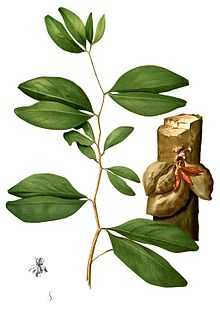Cynometra alexandri
| Uganda ironwood | |
|---|---|
 | |
| Illustration of a related species | |
| Scientific classification | |
| Kingdom: | Plantae |
| (unranked): | Angiosperms |
| (unranked): | Eudicots |
| (unranked): | Rosids |
| Order: | Fabales |
| Family: | Fabaceae |
| Genus: | Cynometra |
| Species: | C. alexandri |
| Binomial name | |
| Cynometra alexandri C.H.Wright | |
The Uganda ironwood or Muhimbi (Cynometra alexandri) is a species of legume that occurs in tropical lowland forests of central and east Africa.[1] They grow gregariously in drier forest types and as a constituent of swamp forests. They reach some 120 feet (37 m) to 150 feet (46 m) in height,[1] and larger trees often develop hollow boles and buttress roots.[1]
Occurrence
In Uganda it is widespread in the lowland forests (below 2,000 metres a.s.l) in the Western Rift Escarpment, where it shows a tendency toward monospecific dominance. After initial colonising, a mixed forest would contain Uganda ironwood, Alstonia congensis, Trichilia prieuriana, Khaya anthotheca and Celtis mildbraedii. When climax forest develops at altitudes between 1,000 and 1,200 m, Uganda ironwood becomes highly dominant.[2] Though a common species, its range has been reduced by wood cutting, large scale farming and subsistence cultivation.
Uses
The durable and dull, reddish brown heartwood is resistant to termite damage or abrasion, while the greyish sapwood is permeable to preservatives. It is employed in industrial or heavy-duty flooring, besides construction, marine work and for railway sleepers.[1]
Due to its physical properties, such as bending strength, inter-node distance, and leaf surface area, the Muhimbi is favoured by chimpanzees for their daily construction of sleeping platforms or “nests”.[3]
Sources
- ↑ 1.0 1.1 1.2 1.3 "Cynometra alexandri". Wood Technical Fact Sheets. USDA Forest Service. Retrieved 30 January 2014.
- ↑ "Uganda broadleaved forests". Closed forests. Food and Agriculture Organization of the UN (FAO). Retrieved 30 January 2014.
- ↑ Samson DR, Hunt KD (2014). "Chimpanzees Preferentially Select Sleeping Platform Construction Tree Species with Biomechanical Properties that Yield Stable, Firm, but Compliant Nests". PLoS ONE 9(4): e95361. doi:10.1371/journal.pone.0095361. Retrieved 17 April 2014.